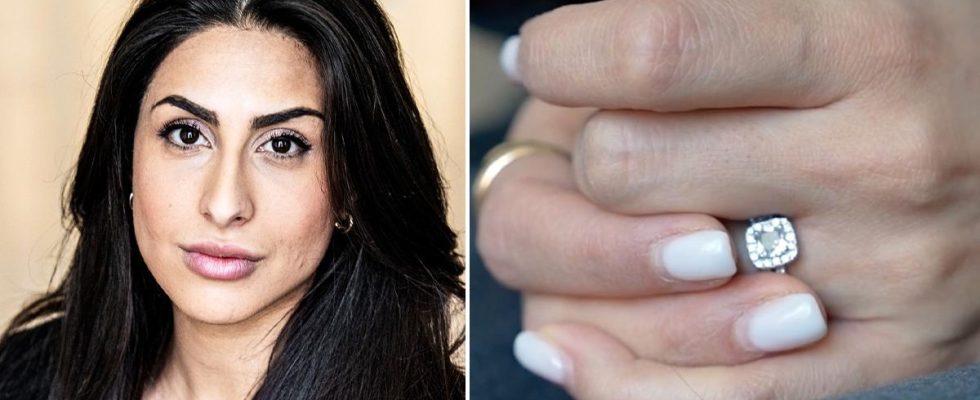unsaveSave
Athena Afshari, 32, has endometriosis.
But it took eight years for care to understand why she was throwing up, in extreme pain and collapsing on her period.
– Time and time again I have been called stupid by doctors who called my symptoms “ordinary period pain”, she says.
During her teenage years, Athena Afshari missed school, had to call in sick from work and was often forced to cancel when she was supposed to hang out with her friends.
All because of the disease endometriosis. Since the age of twelve, she has had symptoms. Pain, vomiting and feeling sick.
But even though she repeatedly sought care, the doctors could not give the correct diagnosis.
– I remember so clearly that I was lying down and screaming from the pain when I had my period. That mother massaged me and held a heating pad against my stomach, while father blew a hair dryer against my back, she says.
Never heard the word endometriosis
expand-left
full screen Athena received her diagnosis after eight years. Photo: Carolina Byrmo
But according to the doctors, the pain was normal, says Athena Afshari.
– But I always had anxiety before my period. I thought it was normal to live the way I did. Always dreading the next period.
But one day the symptoms became unbearable. She then collapsed and had to go by ambulance to a hospital in Stockholm.
At the time, Athena Afshari was 22 years old and had been struggling without a diagnosis for several years. But even then the doctors could not understand the cause of the pain.
– I was sent home without an answer. But after that day, I sought care on my own one last time. Then I first came into contact with a doctor who told me that I probably have endometriosis.
She continues:
– I had never heard that word before.
“Do not give up”
After Athena Afshari was diagnosed – eight years after the first symptoms – she was able to learn to live with the disease.
With help from care, diet and exercise, she now has more good days than bad days.
– The pain can sometimes appear anyway.
When she thinks back to the years without a diagnosis, she says:
– It is so important that young girls receive early treatment. You shouldn’t have to walk around in pain. To those who do not get the right help from healthcare, I want to say one thing: Don’t give up. Change care contacts and find someone who takes you and your pain seriously.
expand-left
full screen Athena Afshari, 32. Photo: Carolina Byrmo
FACT Questions and answers about endometriosis
What is endometriosis?
Endometriosis is a disease that affects about ten percent of all women and people with a uterus. The disease means that the endometrium grows outside the uterus.
It causes bleeding, inflammation and pain. For some patients, untreated endometriosis can cause organs to grow together in the abdomen.
– Some experience pain throughout the menstrual cycle, not just during menstruation. If a patient walks around for too long without receiving the right care, the disease can develop into chronic pain, says Kristin Wennmo Zuk, assistant chief physician at Södersjukhuset.
How many live with the diagnosis?
According to figures from the National Board of Health and Welfare, the number of people treated for endometriosis has more than doubled in recent years, reports SVT.
Kristin Wennmo Zuk highlights, however, that many people still live with strong symptoms and without a diagnosis.
– I meet women in their 50s who have been in pain and unwell for decades. Some have told me that they went to work and spent hours on the toilet. That they spat and fainted, but didn’t report sick – because they thought the symptoms were normal menstrual cramps.
How do you tell the difference between pain and endometriosis?
– Grinding pains are normal during menstruation. If a pain reliever reduces the pain, it is usually a sign that you do not have endometriosis, says Kristin Wennmo Zuk.
– But if your life is affected by the pain. If you cannot go to school, work or other activities, you should seek care. Because it is not pain that you should have to live with.
Is there a cure?
– There is no cure. Traditionally, research and new treatment methods for endometriosis have progressed very slowly. Maybe because it is not a disease that leads to death, but maybe also because it is a women’s disease where many people have been told that it is normal to have pain during periods.
– Today, endometriosis is treated with hormonal treatment and surgery. Research is ongoing into alternative treatment methods that can affect the inflammation that occurs. We believe the future is to tailor the treatment to each individual woman, where some women may be best helped by hormones, others by immunological treatment or surgery.
Read more
